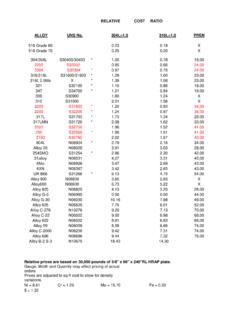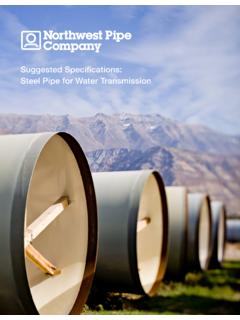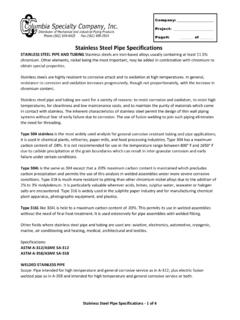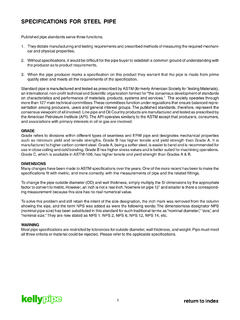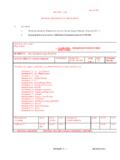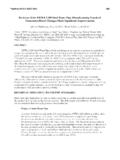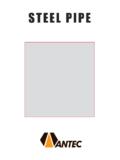Transcription of Welded Steel Pipe - steeltank.com
1 In cooperation with, andeditorial collaboration byWelded Steel PipeDesign Manual2007 EditionMerits, Design Standards, Technical Data and ReferencesD631-07 AcknowledgementsThe American Iron and Steel Institute wishes to acknowledge, with appreciation,the contributions made by past and present members of the STI/SPFA PipeCommittee. Special thanks are given to Robert Card, Victaulic, Inc.; DennisDechant and Bruce VanderPloeg, Northwest pipe Co.; Brent Keil, ContinentalPipe Mfg.; George Ruchti, American Spiral Weld pipe Co.; and George Tupac,Consultant, for assistance in providing this manual. The Committee is gratefulfor the expert assistance of Professor Emeritus Reynold K. Watkins, UtahState University, for his contribution to the new structural analysis used in this volume are courtesy of Victaulic, National WeldingCorp. and STI/SPFA ( Steel Tank Institute/ Steel Plate Fabricators Association).Inquiries regarding copies of this publication may be directed to the above companies, or to:American Iron and Steel Institute1140 Connecticut Avenue, NWSuite 705 Washington, DC 20036(202) Oakwood RoadLake Zurich, IL 60047(847) Steel PipeDesign ManualMerits, Design Standards, Technical Data and ReferencesA compilation of useful information for the design of water transmission linesanddistribution systems using Welded Steel Number D631-0807-ePublished by AMERICAN IRON AND Steel INSTITUTEIn cooperation with, and editorial collaboration by,STI/SPFA( Steel Tank Institute/ Steel Plate Fabricators Association).
2 The material presented in this publication is for general information only andshould not be used without first securing competent advice with respect to itssuitability for any given application. The publication of the material containedherein is not intended as a representation or warranty on the part of AmericanIron and Steel Institute or of any other person named herein that this infor-mation is suitable for any general or particular use or of freedom from infringe-ment of any patents. Anyone making use of this information assumes all liabilityarising from such Steel pipe 1 Research and Development2 Histor y of Steel pipe 3 Search for Strength and Durability3 Long Ser vice Records5 Future of Welded Steel Pipe5 Properties of Steel Pipe61. Strength 62. Ease of Installation63. High Flow Capacity 64. Leak Resistance75. Long Ser vice Life76. Reliability and Conclusions9 Materials11 Structural Analysis of Buried pipe 12 Design and Analysis12 Per formance Limit13 Notation and Nomenclature14 General Analyses 151.
3 Internal Pressure152. Handling and Installing 163. Ring Stability174. Maximum Height of Cover for pipe Held Round 205. Minimum Height of Cover206. Longitudinal Stress Analysis217. Ring Deflection218. Allowable Ring Deflection 229. Backfill and Embedment Specifications 23 Specific Analyses 23 Pertinent Variables23 Performance Limits 25 Design for Internal Pressure 26 Handling 27F-Load at Yield Stress27 Ring Deflection at Yield Stress, due to F-Load27 Soil Mechanics28 Soil Stresses 28 pipe Mechanics32 External Pressures and Loads331. Ring Compression Stress332. Ring Deflection34 Ring Stability 361. Without Soil Support36 Table of ContentsPage2. With Soil Support and No Water Table or Vacuum 373. With Soil Support and Vacuum, Unsaturated Soil 394. With Soil Support, Water Table Above pipe , Saturated Soil 40 Flotation 42 Minimum Soil Cover42 Trench Conditions44 Trench Shield44 Trench Width 45 Parallel Trench47 Embankment Over a Pipe48 Parallel Pipes 48 Longitudinal Analysis 501. Thrust Restraint 502.
4 Longitudinal Contraction513. Beam Action 524. Buried pipe on Piles 52 Backfilling 531. Water Compaction 532. Mechanical Compaction543. CLSM54 Compound Stress Analysis541. Huber-Hencky-von Mises at Mitred Bends55 Strength of Field Welded Joints57 The Effect of Mortar Linings and/or Coatings on Ring Stiffness58 Plastic Analysis 60 Measurement of Radius of Curvature 61 Crack Width Analysis 61 Flowable Fill62 Requirements of the Embedment64 Flowability64 Vertical Compressibility64 Bearing Capacity64 Inspection64 Test Results64 Conclusions65 Linings and Coatings66 Introduction66 Exterior and/or Interior Systems66 AWWA C-20366 AWWA C-20567 AWWA C-21067 AWWA C-22267 Exterior Systems68 AWWA C-20968 Table of Contents (continued)PageAWWA C-21469 AWWA C-21669 AWWA C-21869 Interior Systems69 AWWA C-60269 Coating Application70 Joints 71 Bell and spigot joints with rubber gaskets71 Welded lap joints71 Welded butt joints72 Butt-strap joints72 Mechanical couplings 73 Split-sleeve couplings73 Flanged Joints74 Appendix A75 Useful Publications 79 Standards and Specifications80 Appendix B81 Table of Contents (continued)1 Welded Steel PipeDuring the 20th Centur y, advancements were made insteel pipe in the economy of production and thequality of the product.
5 Noteworthy are the machines andtechnology for cold-forming of flexible pipe from coils ofsheet Steel with automated spiral welds. Great strides weremade in quality control, testing, joints and protective coat-ings. Welded Steel pipe is available in wide ranges of sizesand properties of the Steel . Included in this manual are thedesign criteria for Steel pipe up to 240 inch (6,000 mm) indiameter under either internal or external pressure. Therequirements of buried flexible pipe are: strength, ease ofinstallation, high flow capacity, leak resistance, long ser vicelife, reliability and versatility, and economy. The propertiesof Steel are well adapted to these seven requirements ofburied pipelines. An explanation of each requirement isfound in Properties of Steel pipe , page comprised of two divisions, Steel TankInstitute and Steel Plate Fabricators Association hasser ved water, food, petroleum and chemical markets since1916 as developers of standards and certification programsfor quality, safety and reliability in the manufacture, installa-tion and testing of Steel tanks, piping and pressure North American producers of Steel pipe and pipe -protection materials collaborate with pre-eminent pipelineengineers as members of STI/SPFA.
6 The association andits members sponsor research, and maintain facilities thatper form research, on metallurgy, welding, joints, pipe liningsand coatings. New product developments and improvementsin manufacturing processes are frequently under study. Inaddition, representatives of STI/SPFA and their membersserve on committees engaged in the preparation of nationalcodes, standards and specifications for the design, installa-tion and operation of Steel tanks and American Iron and Steel Institute (AISI) ser ves as thevoice of the North American Steel industr y in the publicpolicy arena and advances the case for Steel in the market-place as the material of choice. AISI also plays a lead rolein the development and application of new steels and Steel -making technology. AISI s Market Development mission isto grow the competitive use of Steel through a market-drivenstrategy that promotes cost-effective, Steel -based program focuses on the automotive, construction andcontainer markets.
7 AISI's member companies representapproximately 75% of both and North American andDevelopmentHistory of Steel Pipe3 Pipes for water supply began to be used around 2500 Chinese transported water through bamboo. InSouthern Europe and the Near East, tile pipes were craftedto supply water for the baths of kings and emperors. Theage of iron began about 1000 Classical historiansdon t spend their time investigating pipes; however, bits ofinformation on pipe development have been recorded byengineers. One such document is Histor y of Steel WaterPipeby Walter H. Cates, who spent his professional lifetimedesigning Steel pipes with Consolidated Western Steel , aDivision of Steel Corp. Parts of the following areabstracted from Walter Cates for Strength and DurabilityBefore the 19th Centur y, iron was used mostly for weapons:spears, swords, muskets and cannons. In England in 1824,James Russell invented a machine for welding iron tubes. In1825, Cornelius Whitehouse invented a method for makingpipe by drawing long, flat strips of hot iron through a bell-shaped die.
8 These inventions opened the way for iron pipe had much more strength and durability than pipesof tile or the Russelland Whitehouseinventions, inter-est in iron pipesoared. Majordevelopmentoccurred in fourstages:1. In 1830, thefirst furnacewas built inthe UnitedStates formakingwrought ironpipe. Soonthereafter,more furnacescame into pro-City of San Francisco, California Baycrossing of the Hetch Hetchy inches diameter, 3 8-inch and l 2-inchsteel The demand was enormous because of the needfor water distribution in fast-growing cities. Those wroughtiron pipes were in small diameters and few sizes. Productionwas limited because iron was not available in large Age of Steel was born in 1855 in England, where SirHenr y Bessemer patented a process for production of of the open hearth furnace in 1861 madeinexpensive Steel available in large quantities thousandsof tons. Before then, Steel had been available only by thepound. Steel made it possible to cold form sheets intopipes of any diameter.
9 Soon after the 1849 gold rush in California, Englishsheet Steel was formed into tubes with longitudinal riveted seams. One end ofeach pipe stick was crimped so it could be stabbed into the next stick likestove pipes. Sections were joined by simply hammering them together. From1860 to 1900, virtually all water pipe was cold formed from Steel sheets andriveted. More than 2 million feet were installed during that third major development was Lock-Bar Steel pipe in 30-foot lengths. It wasfirst fabricated in 1905 in New York. Two semi-circular pipe halves were joinedby inserting the edges of each into two longitudinal lock-bars with an H-shapedcross section. The edges of the pipe halves were planed and up-set to a slightlygreater thickness to form a shoulder for engaging the lock-bar. The lock-barwas then closed under 350 tons per foot of length. The pipe edges wereclamped in the lock-bar. The seam was 100% efficient. Some single rivetedseams were only 45% efficient, and double riveted seams only 70% interior of this new pipe was smoother than riveted pipe .
10 Carr ying capabilitywas increased by 15% to 20%, according to the manufacturer. Lock-Bar madeinroads into the Steel pipe market. Data from 1915 to 1930 indicate millionfeet of Lock-Bar was installed vs. million feet of riveted fourth major development was automatic electric welding. Electric weldingstarted as a novelty in 1920, but made great progress during the 1930s,when welding machines and fluxes were developed. From 1920 to 1940,approximately 7 million feet of Welded Steel pipe were installed. During WorldWar II, virtually all Steel production was diverted into military equipment, armsand armament. Navy ships were Welded to shorten the time of technology improved. After the war, the latter half of the 1940s, pro-duction began of Welded Steel pipe by straight seam electrical resistance andfusion welding. Spiral fusion welding was just coming on line. The 1950sbegan an era of longer and larger 1858, Steel sheets, shipped to San Francisco for buildingneeds, were rolled into pipe 11 inches to 22 inches indiameter and installed in Calaveras County, Calif.






